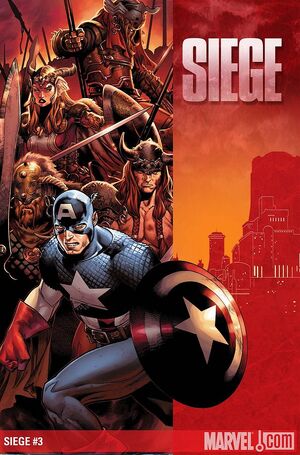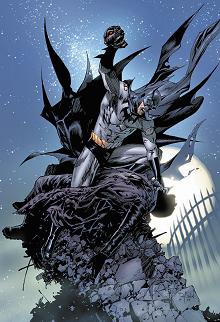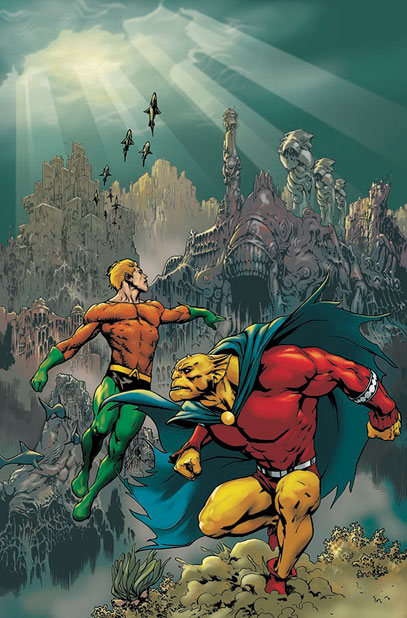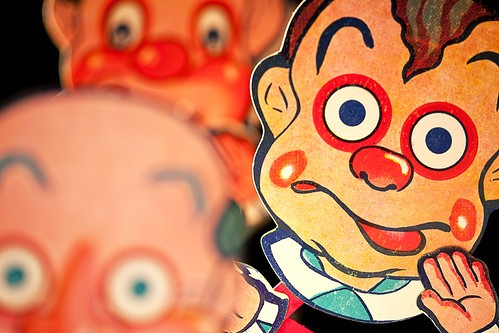 Streets of Gotham #10: After reading this Damien-centric issue, I can honestly say that this little ninja is the only Robin who I actually want to see get a solo series. Paul Dini has always been a solid and reliable Batman writer, but he's really coming into his own on this title. It helps that Nguyen's Gotham is not a place of great towers or epic monuments. On the ground level, Gotham is a filthy, crime-ridden metropolis, and Nguyen perfectly captures this sense of urban desolation. Dini also does a great job of creating a truly menacing Mr. Zsasz. Though he's not super-powered (or a criminal genius in the vein of the Joker), Zsasz is one of the more frightening members of Batman's Rogue's gallery, if only because his breed of sadism is simple and believable. Across the board, Batman books have been really great lately, and Streets of Gotham rounds out the line-up nicely, providing some excellent straight-forward Dark Knight storytelling.
Streets of Gotham #10: After reading this Damien-centric issue, I can honestly say that this little ninja is the only Robin who I actually want to see get a solo series. Paul Dini has always been a solid and reliable Batman writer, but he's really coming into his own on this title. It helps that Nguyen's Gotham is not a place of great towers or epic monuments. On the ground level, Gotham is a filthy, crime-ridden metropolis, and Nguyen perfectly captures this sense of urban desolation. Dini also does a great job of creating a truly menacing Mr. Zsasz. Though he's not super-powered (or a criminal genius in the vein of the Joker), Zsasz is one of the more frightening members of Batman's Rogue's gallery, if only because his breed of sadism is simple and believable. Across the board, Batman books have been really great lately, and Streets of Gotham rounds out the line-up nicely, providing some excellent straight-forward Dark Knight storytelling. Scalped #36: With each new issue, my love for Scalped becomes more and more fanatical, slowly mutating into outright obsession. To be honest, I don't know if I can fairly review Scalped anymore; I'm too involved. From the very beginning, this book has had balls. And I don't mean balls in an "it's explicitly violent" way; I mean that Jason Aaron is not afraid take the book into increasingly uncomfortable and taboo territory. More than that, he constantly gives side characters whole story-arcs that are just as important and as good as the A-character arcs. This time, the focus is on Shunka, Chief Red Horse's enforcer and right-hand man. Shunka has been one of the best characters on the cast from the start, but wow, you'd have to be watching him pretty close to see this coming. It's doubly impressive that this issue comes after last month's relatively quiet stand-alone. The increasingly complex world of Scalped is downright jaw-dropping, and if you're not reading this book you need to start. In my completely biased opinion, Scalped is a crime drama of unparalleled substance and quality.
Scalped #36: With each new issue, my love for Scalped becomes more and more fanatical, slowly mutating into outright obsession. To be honest, I don't know if I can fairly review Scalped anymore; I'm too involved. From the very beginning, this book has had balls. And I don't mean balls in an "it's explicitly violent" way; I mean that Jason Aaron is not afraid take the book into increasingly uncomfortable and taboo territory. More than that, he constantly gives side characters whole story-arcs that are just as important and as good as the A-character arcs. This time, the focus is on Shunka, Chief Red Horse's enforcer and right-hand man. Shunka has been one of the best characters on the cast from the start, but wow, you'd have to be watching him pretty close to see this coming. It's doubly impressive that this issue comes after last month's relatively quiet stand-alone. The increasingly complex world of Scalped is downright jaw-dropping, and if you're not reading this book you need to start. In my completely biased opinion, Scalped is a crime drama of unparalleled substance and quality.Marvel:
 Breaking into Comics the Marvel Way #2 (of 2): Not a lot to say about this, as it's pretty much the same format as issue #1. Of the up-and-coming artists featured here, my three picks are Tommaso Bennato, Stephen Thompson, and Gabriel Hernadez Walta. Also, I think the back-up materials in this issue are better than the first. C.B. Cebulski's 140-character or less advice in the back is great for artists and writers alike, as it gives clear and succinct words of wisdom for working in comics. Other than that, I'd say only pick this up if you like anthology-style storytelling or you're looking to see what artists are on the cusp of breaking through.
Breaking into Comics the Marvel Way #2 (of 2): Not a lot to say about this, as it's pretty much the same format as issue #1. Of the up-and-coming artists featured here, my three picks are Tommaso Bennato, Stephen Thompson, and Gabriel Hernadez Walta. Also, I think the back-up materials in this issue are better than the first. C.B. Cebulski's 140-character or less advice in the back is great for artists and writers alike, as it gives clear and succinct words of wisdom for working in comics. Other than that, I'd say only pick this up if you like anthology-style storytelling or you're looking to see what artists are on the cusp of breaking through. Marvels Project #7 (Ed Brubaker, Steve Epting): With the series' penultimate issue, the Marvels Project continues to be an impressive display of a phenomenal writer/artist combo. But for all the good things about the Marvels Project, I still have a hard time finding it compelling. This could be because we already know how it's going to end, or it could be the pacing of the story. Although none of the initial issues were bad by any stretch of the imagination, it seems as though the action hasn't really picked up until these most recent two or three issues. At the risk of repeating myself, I feel that the Marvels Project will make for a much stronger story once it's collected in a trade or hardback; as a series of single issues, it's hard to stay interested. Issue #7 does deserve a fair share of praise though, as Brubaker proves yet again that his strength lies in building a complete sense of a character in only a few pages. More so than other high-profile writers, Brubaker understands how to craft tightly constructed characterization through dialogue and narration. But while the Marvels Project is good, I can't help but feel that Brubaker/Epting's time would be better spent telling a new story.
Marvels Project #7 (Ed Brubaker, Steve Epting): With the series' penultimate issue, the Marvels Project continues to be an impressive display of a phenomenal writer/artist combo. But for all the good things about the Marvels Project, I still have a hard time finding it compelling. This could be because we already know how it's going to end, or it could be the pacing of the story. Although none of the initial issues were bad by any stretch of the imagination, it seems as though the action hasn't really picked up until these most recent two or three issues. At the risk of repeating myself, I feel that the Marvels Project will make for a much stronger story once it's collected in a trade or hardback; as a series of single issues, it's hard to stay interested. Issue #7 does deserve a fair share of praise though, as Brubaker proves yet again that his strength lies in building a complete sense of a character in only a few pages. More so than other high-profile writers, Brubaker understands how to craft tightly constructed characterization through dialogue and narration. But while the Marvels Project is good, I can't help but feel that Brubaker/Epting's time would be better spent telling a new story. New Avengers #63: I don't know what it's going to take for me to feel compelled to read New Avengers again. This issue really pulls on the heartstrings, by focusing on two relationships within the New Avengers as they head into the battle for Asgard. To be honest, I kinda want the New Avengers to go away. Maybe it's because the New Avengers have always felt like a team that was custom built for big events. Maybe I'm just tiring of Bendis' dialogue, of which there is a lot in this issue. Maybe I just miss Doctor Strange. Bendis does a good enough job at humanizing this current battle, but it's a little too much to have major characters essentially spell out their emotional drives for the reader. On the plus side, artist Mike McKone's opening splash page sure is pretty. So while Dark Avengers heads for what is sure to be a great ending, New Avengers looks like it might go out with a whimper, which is a shame since the title started out so good.
New Avengers #63: I don't know what it's going to take for me to feel compelled to read New Avengers again. This issue really pulls on the heartstrings, by focusing on two relationships within the New Avengers as they head into the battle for Asgard. To be honest, I kinda want the New Avengers to go away. Maybe it's because the New Avengers have always felt like a team that was custom built for big events. Maybe I'm just tiring of Bendis' dialogue, of which there is a lot in this issue. Maybe I just miss Doctor Strange. Bendis does a good enough job at humanizing this current battle, but it's a little too much to have major characters essentially spell out their emotional drives for the reader. On the plus side, artist Mike McKone's opening splash page sure is pretty. So while Dark Avengers heads for what is sure to be a great ending, New Avengers looks like it might go out with a whimper, which is a shame since the title started out so good. Thor #608: I have to give Kieron Gillen credit for keeping the focus of Thor on the Asgardians during Siege, as Thor's supporting cast has always been one of the best parts of the series. However, it's hard to buy that the Asgardian warriors are this downtrodden and easily bested by an army of Mortals and Super-foes. Sure, the Sentry is all-powerful, and the Hood has some Norse-powered stones at his disposal, but what about all those H.A.M.M.E.R. agents and the Hood's C-List squad? They can beat Norse God-Warriors? Sorry, I don't buy it. Though I ragged on it last month, Volstagg's redemptive battle against Thor-clone Ragnagok is actually pretty entertaining, if only because it shows how this whole event has affected the rotund warrior. This issue was also a bit unbalanced due to the art duties being handled by two separate artists. It's an interesting way to differentiate between separate plots, but I can't help but feel that it was done because the stories were written only to function as filler, biding time until Siege is over.
Thor #608: I have to give Kieron Gillen credit for keeping the focus of Thor on the Asgardians during Siege, as Thor's supporting cast has always been one of the best parts of the series. However, it's hard to buy that the Asgardian warriors are this downtrodden and easily bested by an army of Mortals and Super-foes. Sure, the Sentry is all-powerful, and the Hood has some Norse-powered stones at his disposal, but what about all those H.A.M.M.E.R. agents and the Hood's C-List squad? They can beat Norse God-Warriors? Sorry, I don't buy it. Though I ragged on it last month, Volstagg's redemptive battle against Thor-clone Ragnagok is actually pretty entertaining, if only because it shows how this whole event has affected the rotund warrior. This issue was also a bit unbalanced due to the art duties being handled by two separate artists. It's an interesting way to differentiate between separate plots, but I can't help but feel that it was done because the stories were written only to function as filler, biding time until Siege is over. Secret Warriors #14: This is another Secret Warriors issue where there's not a lot of action, but the greater gears continue to move us slowly toward one hell of a resolution. The depths of Contessa's/Madame Hydra's treachery are revealed, Hydra deals with the realization that they've been betrayed, and two members Nick Fury's team face a team roster shake-up. It's fun to see the different methods of these three clandestine organizations as they try to gain leverage against the others. And while some critics continue to accuse this book of moving too slowly, I think that Hickman and Caselli have accomplished something truly worthwhile: they've managed to make a complicated espionage story that holds it's own in a market of action-packed superhero extravaganzas. Though it's hardly a book for everyone, I'm continually surprised by the high caliber storytelling of Secret Warriors.
Secret Warriors #14: This is another Secret Warriors issue where there's not a lot of action, but the greater gears continue to move us slowly toward one hell of a resolution. The depths of Contessa's/Madame Hydra's treachery are revealed, Hydra deals with the realization that they've been betrayed, and two members Nick Fury's team face a team roster shake-up. It's fun to see the different methods of these three clandestine organizations as they try to gain leverage against the others. And while some critics continue to accuse this book of moving too slowly, I think that Hickman and Caselli have accomplished something truly worthwhile: they've managed to make a complicated espionage story that holds it's own in a market of action-packed superhero extravaganzas. Though it's hardly a book for everyone, I'm continually surprised by the high caliber storytelling of Secret Warriors. Uncanny X-Men #522: Heeeerrrrre's Kitty! After months of waiting patiently, Kitty Pride is back, although it doesn't look like things are going to be all hunky dory for awhile. Matt Fraction does a good enough job of getting Kitty back while also building toward "Second Coming," although I don't know if I have it in me to stick around and see what happens next. There's a good chunk of characterization here, particularly centering around the dynamic between Emma Frost, Cyclops, and Magneto. But for such an important issue, the ending definitely left me cold. In a series of silent panels, we're shown various members of the X-cast, in a section meant to catch up all the readers who (like me) grabbed this just because it was the return of Kitty Pryde. It felt a little bit like those old slow-motion endings to episodes of Lost. However, the silent panels lack any sort of emotional structure or gravity, and thereby subvert an otherwise satisfying conclusion.
Uncanny X-Men #522: Heeeerrrrre's Kitty! After months of waiting patiently, Kitty Pride is back, although it doesn't look like things are going to be all hunky dory for awhile. Matt Fraction does a good enough job of getting Kitty back while also building toward "Second Coming," although I don't know if I have it in me to stick around and see what happens next. There's a good chunk of characterization here, particularly centering around the dynamic between Emma Frost, Cyclops, and Magneto. But for such an important issue, the ending definitely left me cold. In a series of silent panels, we're shown various members of the X-cast, in a section meant to catch up all the readers who (like me) grabbed this just because it was the return of Kitty Pryde. It felt a little bit like those old slow-motion endings to episodes of Lost. However, the silent panels lack any sort of emotional structure or gravity, and thereby subvert an otherwise satisfying conclusion.Image:
 King City #6 (Brandon Graham): Whenever the an issue of King City hits stands, it's a cause for comic celebration. In the last of the previously published material, the Cat Master of King City has a showdown with some real evil baddies of the psychic/undead variety. Plus, we finally get the long-awaited reunion of Joe and Anna, as well as a great cat-vs-squid monster battle. King City is a book that deserves praise for a multitude of reasons, not the least of which being Graham's ability to create a refreshingly original and fun science fiction story. There's nothing else out there like King City. Say what you will about Image as a publisher, but they've earned big-time points with me for reviving the otherwise dormant brilliance of King City.
King City #6 (Brandon Graham): Whenever the an issue of King City hits stands, it's a cause for comic celebration. In the last of the previously published material, the Cat Master of King City has a showdown with some real evil baddies of the psychic/undead variety. Plus, we finally get the long-awaited reunion of Joe and Anna, as well as a great cat-vs-squid monster battle. King City is a book that deserves praise for a multitude of reasons, not the least of which being Graham's ability to create a refreshingly original and fun science fiction story. There's nothing else out there like King City. Say what you will about Image as a publisher, but they've earned big-time points with me for reviving the otherwise dormant brilliance of King City. Orc Stain #2 (James Stokoe): In as much as King City succeeds due to Graham's graffiti-leaning spacious style, James Stokoe's work in Orc Stain is equally as impressive for opposite reasons. Where Graham's city is full of wide open spaces and broad curves, Stokoe's savage planet is jam-packed with astoundingly detailed, sharp illustrations. Even if the story sucked (which it doesn't), Orc Stain would be worth checking out if only for the art. Just take a look at that cover and try to tell me this isn't a book you'd at least flip through. Having read his previous book for Oni, Wonton Soup (which is also highly recommend), I can say that Stokoe's strengths as a storyteller are definitely improving. He's taken a fantasy staple, roughed up the edges and created a fresh and raw world. If you are a fan of Conan the Barbarian, Heavy Metal, or any similar brand of violent, sexual fantasy, you owe it to yourself to check out Orc Stain. In fact, the only foreseeable problem with Orc Stain is that it's probably going to be one of those books that ships infrequently; but keeping in mind that Stokoe writes, draws, colors, and letters the book, I'm going to go ahead and say it will always be worth the wait.
Orc Stain #2 (James Stokoe): In as much as King City succeeds due to Graham's graffiti-leaning spacious style, James Stokoe's work in Orc Stain is equally as impressive for opposite reasons. Where Graham's city is full of wide open spaces and broad curves, Stokoe's savage planet is jam-packed with astoundingly detailed, sharp illustrations. Even if the story sucked (which it doesn't), Orc Stain would be worth checking out if only for the art. Just take a look at that cover and try to tell me this isn't a book you'd at least flip through. Having read his previous book for Oni, Wonton Soup (which is also highly recommend), I can say that Stokoe's strengths as a storyteller are definitely improving. He's taken a fantasy staple, roughed up the edges and created a fresh and raw world. If you are a fan of Conan the Barbarian, Heavy Metal, or any similar brand of violent, sexual fantasy, you owe it to yourself to check out Orc Stain. In fact, the only foreseeable problem with Orc Stain is that it's probably going to be one of those books that ships infrequently; but keeping in mind that Stokoe writes, draws, colors, and letters the book, I'm going to go ahead and say it will always be worth the wait. Shuddertown #1 (Nick Spencer, Adam Geen): There's little worse than a comic book that suffers from too much narration. Unfortunately, Shuddertown is such a book. From the first page on, we're basically told that our narrator is not to be trusted. When an unreliable narrator is just flat-out acknowledged, the fun of figuring it out for ourselves is taken away. This is a shame, because there is a lot to like about Shuddertown. The set-up is interesting enough to keep reading, the protagonist (when he shuts up) feels like a real character, and the art is genuinely impressive. In fact, Adam Geen's work with both pencils and coloring are the best part of this comic. I'm holding out faith that the series will be able to escape the burden of its narrator, as I genuinely think that Shuddertown has the potential to be a great crime series.
Shuddertown #1 (Nick Spencer, Adam Geen): There's little worse than a comic book that suffers from too much narration. Unfortunately, Shuddertown is such a book. From the first page on, we're basically told that our narrator is not to be trusted. When an unreliable narrator is just flat-out acknowledged, the fun of figuring it out for ourselves is taken away. This is a shame, because there is a lot to like about Shuddertown. The set-up is interesting enough to keep reading, the protagonist (when he shuts up) feels like a real character, and the art is genuinely impressive. In fact, Adam Geen's work with both pencils and coloring are the best part of this comic. I'm holding out faith that the series will be able to escape the burden of its narrator, as I genuinely think that Shuddertown has the potential to be a great crime series.Dynamite:
 Robocop #3 (Rob Williams, Fabiano Neves): After laying a solid foundation of satire in the vein the original film, the third issue of Dynamite's Robocop begins to feel a bit like the 3rd act of the film; more action, less commentary. This isn't all bad though, as now the plot can move forward in all it's explosively gory glory. So though it's not as funny as the previous issues, the story continues to impress. The writer/artist team of Rob Williams and Fabiano Neves are doing a bang-up job of expanding the Robocop mythos, driving the corporate evil of OCP in a satisfying direction (gigantic ED-209s included) and paying homage to both the obvious and understated themes established in the original film. Neves deserves special credit for capturing Robocop's awkward movements and posture, although he does tend to move a little too swiftly at times. For long-time Robocop fans desperate for a fix, this series continues to satisfy.
Robocop #3 (Rob Williams, Fabiano Neves): After laying a solid foundation of satire in the vein the original film, the third issue of Dynamite's Robocop begins to feel a bit like the 3rd act of the film; more action, less commentary. This isn't all bad though, as now the plot can move forward in all it's explosively gory glory. So though it's not as funny as the previous issues, the story continues to impress. The writer/artist team of Rob Williams and Fabiano Neves are doing a bang-up job of expanding the Robocop mythos, driving the corporate evil of OCP in a satisfying direction (gigantic ED-209s included) and paying homage to both the obvious and understated themes established in the original film. Neves deserves special credit for capturing Robocop's awkward movements and posture, although he does tend to move a little too swiftly at times. For long-time Robocop fans desperate for a fix, this series continues to satisfy.





































 Point yer podcatcher here!
Point yer podcatcher here!